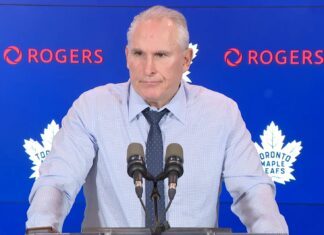Part 2 of the trade target series covers three wingers and one center option if the Maple Leafs dip into the trade market to address their offseason needs at the forward position.
In case you missed it, Part 1 assessed the availability and fit of Lawson Crouse, Dawson Mercer, and Ross Colton.
Last summer, there were clear holes on the Leafs’ defense amid one of the best UFA defense markets in recent memory. It was a straightforward situation, and the Leafs signed two solid veteran defensemen and hit on their goalie addition. This summer, I don’t think they can adequately complete their shopping through only the UFA market, and as we sifted through the options last week, this became abundantly clear.
While the Leafs don’t own a ton of assets to throw around in trades, they are armed with cap space, which should make them competitive in the trade market; teams around the league are always looking to shed money.
The draft/summer is generally a great time to make trades at much lower costs. We see it happen in the league pretty regularly. Last offseason, the Ottawa Senators traded Nick Jensen and a third-round pick for Jakob Chychrun, who was 26 years old at the time and followed up the trade with a 20-goal season and a long-term contract extension in Washington.
Plus, there is the potential benefit of trading for players already signed to contracts negotiated before the salary cap increased. The alternative is diving into a free agent market where players are positioning for new contracts based on the most notable cap jump in seven years.
Tack on the relatively weak UFA crop in general, and it’s a no-brainer for the Leafs to dive into the trade market and weaponize their cap space. Truthfully, I’d be disappointed if Treliving made zero trades of note this summer.
Jonathan Marchessault

- Age: 34, turning 35 in December
- Height and Weight: 5’9, 185
- Contract: Four more years at $5.5 million per season
- Season Stats: 21 goals, 56 points, 78 games, 17:59 per game, 48.07 CF%, 47.84 xGF%
Why he might be available
Nashville’s season was a disaster after they spent heavily in the 2024 offseason. The pieces just didn’t fit, and now they are saddled with a collection of lengthy contracts for players in their 30s. Marchessault stands out as a player the Predators can move more easily than Steven Stamkos at $8 million per season, or Brady Skjei and his six remaining years at $7 million AAV. Nashville has a collection of right-shot forwards who are goal scorers, making it a weird fit. The Predators are probably better than they showed last season as a team overall, but they need to change some of the puzzle pieces, too.
Things to Like
It’s not like Marchessault’s production fell off a cliff in 2024-25; he scored 21 goals and 56 points on a team that was second last in the league in goals per game. Does that sound like a player who is fully washed up? In the season prior, he went nuclear with 42 goals, and while that’s likely never happening again, he’s a legitimate 20+ goal scorer. While he’s undersized, he plays with some edge and will happily go to the dirty areas.
When Vegas won the Cup, Marchessault was in the running for the Conn Smythe Trophy, scoring 13 goals and putting up 25 points in 22 games. He has 76 points (36 goals) in 102 career playoff games overall. He’s shown he can elevate in big games (in the run to the SCF in 2018, he piled up 21 points in 20 games, too). Marchessault has won his minutes at five-on-five in the playoffs every single year he’s played in them.
While he’s an older player, all sorts of veterans thrived in the playoffs this spring, including the Leafs‘ own Max Pacioretty. When it comes to veterans who can consistently elevate in the playoffs because of their style of play, Marchessault fits the bill.
I also don’t think you need to be a big player to thrive in Berube’s system. It’s not a prerequisite; Jaden Schwartz was second on the Blues in scoring when St. Louis won the Cup. Marchessault is talented enough to play alongside the Leafs’ top players, and when we talk about the Knies-Matthews-Marner line outscoring opponents 36-23 and finding a new RWer who can help replicate that output, Marchessault stands out as an option. He can put the puck in the net, grind pucks in the offensive zone, and make plays alongside other skilled players. He’s also a right-handed shot on a team that lacks them.
Cause for Concern
Marchessault hasn’t lost his scoring touch, but his skating is in decline, and he’s turning 35 at the end of the year. Old, slowing down, and small is not a great recipe. The cost to acquire Marchessault needs to reflect this reality. Nashville should be looking to get out from under the contract before it really becomes a liability. The interest from the Leafs’ perspective should be in adding him at a discount and squeezing out the remaining value before the contract becomes a real problem.
Auston Matthews has three years remaining on his deal, and the next few seasons, in particular, are really the team’s Cup window. If the Leafs can get at least two good years out of Marchessault, including pairing him with Matthews on a top line — comfortably allowing them to shift William Nylander elsewhere — it’s worth taking on the downside of the contract at a low cost. If Marchessault continues to steadily decline, it quickly becomes an albatross. Those are the pros and cons to weigh from the Leafs’ perspective.
Andrew Copp

- Age: 30, turning 31 in July
- Height and Weight: 6’1, 203
- Contract: Two more years at $5.625 million per season
- Season Stats: 10 goals, 23 points, 56 games, 14:42 per game, 46.94 CF%, 46.86 xGF%
Why he might be available
The Red Wings have struggled since signing Copp to his current contract, which he hasn’t lived up to since signing in Detroit. I don’t think both those things fall on Copp exclusively, but teams in this position generally look to make changes. He landed on Nick Kypreos’ trade board as well, so it’s likely known around the league that he could be available, and with two years remaining, it may be a contract that Detroit is looking to shed and go in a different direction altogether.
Things to Like
Most of our lists so far have been generally devoid of centers. That’s not on purpose. It’s a clear need for the Leafs, just like it is for 80+% of the league. Good centers are hard to come by — they aren’t widely available on the UFA or trade market because teams are starving for quality Cs — and sometimes, it requires a shot on a player who could rebound.
New Leafs assistant coach Derek Lalonde recently coached Copp in Detroit, so you’d like to think he’d have some good intel on the player and whether he’s worth pursuing. Considering Copp has a modified NTC, you’d like to think it’d be an easy deal to put together if the two were fond of each other.
Three years ago, Copp was coming off a great stint with the Rangers, where he went over a point per game following a deadline trade and chipped in 14 points in 20 playoff games during an Eastern Conference Finals run. He signed a big deal to join a bad Detroit team and didn’t live up to the contract, but I don’t think that makes him a bad player; it was partly on the team acquiring the wrong player at the wrong time. His cap hit has been onerous so far relative to his on-ice contribution, but as the cap rises, it will be far less of an issue.
Copp, for my money, still generally provides what he did a few years ago: a versatile middle-six forward who can play center, contribute on both special-teams units, and be reliable in every situation, whether that’s chipping in offense or defending (including closing out games). He’s turning 31 in a month, so he’s not exactly old to the point where his game should have completely fallen off a cliff.
Even in recent down years, Copp has played to a 34-point pace while capably playing center on a mediocre team that asked him to do too much; in his first season, in particular, he averaged over 18 minutes per game with the Red Wings. That Detroit team was terrible and was outscored by 37 at five-on-five, but Copp drew dead even in goal share. In the following season, he was outscored by four on a team that was outscored by 12, and this past season, he won his minutes by one before getting injured. He hasn’t been run over in his minutes despite being surrounded by poor defense and goaltending units.
Copp is not a stud, and the Leafs would not be gambling on the upside of a younger player, but the bet is that he’s a solid, useful veteran who would fare better in a different environment. It’s easy to picture Copp fitting alongside Scott Laughton on a responsible two-way line that can chip in offense, or moving to center (including centering Nylander at times), or playing on his wing as a responsible veteran who is good enough to make plays with the puck.
If the cost is cheap and borders on free because Detroit wants to dump Copp’s contract, it’s a decent buy-low opportunity and a good, relatively safe option for a Leafs team that iced a third line featuring Steven Lorentz and Calle Jarnkrok in the playoffs.
Cause for Concern
Copp has played to a 12-goal, 35-point pace over 82 games for his career, so for over $5 million, it’s not great bang for the buck, even with the cap rising. If he steadily declines below those numbers, his contract is a problem, and now we’re in the worrisome zone of overpaying for mid-pack players instead of saving the cap space for genuine needle movers.
While Copp can chip in with certain units, he’s been part of really poor Red Wings penalty kills (admittedly, their goaltending has been awful in his time there), and he’s not going to see top-line power-play time with the Leafs unless something goes horribly wrong. He’d need to be a good five-on-five option and provide solid hockey down the middle of the ice at this price tag.
I tend to lean towards Copp as a better choice than most of the UFA options at center at this point, and that’s why I’ve included him on this list. That said, the price has to be dirt cheap to justify taking the remaining two years of his deal. The Leafs aren’t going to pay for retention, but they have the cap space to take on a deal like this without much of an issue.
Copp would have to earn from it there, and so far, he’s had trouble holding up his end of the deal on a much weaker Red Wings team. He’s probably not going to excite anyone in Toronto — and that’s fine — but he’s a solid, competent center. I’d wager that he’s a better player than he showed in Detroit if he’s on a good hockey team.
Evander Kane

- Age: 33, turning 34 in August
- Height and Weight: 6’2, 218
- Contract: One more year at $5.125 million
- Season Stats: Didn’t play all season
Why he might be available
The Oilers have under $12 million in cap space, not accounting for the Trent Frederic extension to be announced shortly, plus Evan Bouchard is an RFA who will get paid. To pay Bouchard alone — never mind improving their roster otherwise — they will need to clear cap, and Kane is turning 34 this summer, didn’t play a game all season, and is making over $5 million. They’d love to clear the cap space.
Things to Like
The extent of my interest in Kane primarily falls in the category of a cheap backup option if all else fails. Mason Marchment just moved for a third and a fourth, and he makes less, actually played this season, and is five years younger. If nothing else, acquiring Kane for essentially free as he enters a contract year presents an opportunity for good value. He’s a proven top-six forward when he’s on his game, and even if he was middling, the Leafs could retain salary, flip him, and likely still come out ahead. If he fits in well, it’s gravy.
Over his last three seasons, Kane has played to a 32-goal, 57-point pace over 82 games and has 55 career playoff points in 97 career games. While he missed the entire 2024-25 regular season, he came back and showed well enough in the playoffs (12 points in 21 games) to believe that with a full summer of training ahead, he’d produce just fine in the regular season. He still has jam and a dirty streak in his game; he can get carried away at times, but I generally don’t mind that trade-off on a team that has largely played within the rules for years now.
A good contract year from Kane is a reasonable bet — he is talented — and he would add a third power forward to the Leafs’ lineup that they could spread out across three lines (along with Matthew Knies and Bobby McMann). All three are legitimate 20+ goal threats, and it further supports the style the Leafs want to play under Berube.
Cause for Concern
Kane has never been great defensively, and it is not going to change at this point. Can he play on a line with William Nylander, then? If not, will he be effective enough on a line with Auston Matthews? Kane is best slotted as a top-six forward, so he really needs to fit on one of the Leafs’ top two lines.
Kane is also prone to taking bad penalties and led the playoffs with a -10 penalty differential. Max Domi was right behind him at -8; can those two really coexist on a team if they are regularly taking penalties?
We haven’t even gotten to the caveats of Kane turning 34 years of age, missing all of last season, and bringing a lot of mileage and baggage. If anything, the Oilers might have to sweeten the pot.
Yegor Chinakhov

- Age: 24
- Height and Weight: 6’1, 201
- Contract: One year at $2.1 million
- Season Stats: 7 goals, 15 points, 30 games, 15:43 per game, 53.11 CF%, 51.41 xGF%
Why he might be available
The Blue Jackets are stocked with young talent on their roster and throughout the organization. Chinakhov is included in that mix, but he has battled injury issues every season, and GM Don Waddell is on the record stating he doesn’t like players who can’t stay healthy.
Chinakhov is also yet to truly break out or establish himself in the league by age 24. The Blue Jackets have eight NHLers signed already at forward and another quality one in Dmitry Voronkov, who is an RFA they will surely keep. It doesn’t seem like they want Chinakhov occupying one of those other three spots.
Things to Like
Chinakhov is the biggest question mark in the group, but he’s young and represents real upside. He has a great shot, he’s a good skater, he has decent size, and he has hovered around .5 points per game in the past three seasons. Chinakhov is clearly talented, but he needs to stay healthy to allow himself the proper time to put it all together. For a Leafs team running one of the oldest rosters in the league, there’s continued interest (at least on my end) in adding an injection of youth to the roster.
This, more than anything, is purely a buy-low on talent that’s worn out his welcome elsewhere. Rather than dwell on the injury issues, it’s more about hoping a first-round pick in 2020 with clear talent and pedigree can put it all together after a change of scenery.
Cause for Concern
Beyond the injury history, the main concerns center around Chinakhov’s role in the league. While the talent is clear, he hasn’t exactly put together a top-six-forward-worthy campaign; his career-best season was 16 goals and 29 points in 53 games. If he can’t produce enough to play in the top six, can he play on a checking line on a team with designs on a deep playoff run?
Of the players on this list, Chinakhov is the least likely to help the Leafs win this year, and are the Leafs okay with spending assets with that in mind? I don’t think Columbus is at a point where they would give Chinakhov away for free.















![John Gruden after the Leafs prospects’ 4-1 win over Montreal: “[Vyacheslav Peksa] looked really comfortable in the net… We wouldn’t have won without him” John Gruden, head coach of the Toronto Marlies](https://mapleleafshotstove.com/wp-content/uploads/2025/09/gruden-post-game-sep-14-218x150.jpg)


















